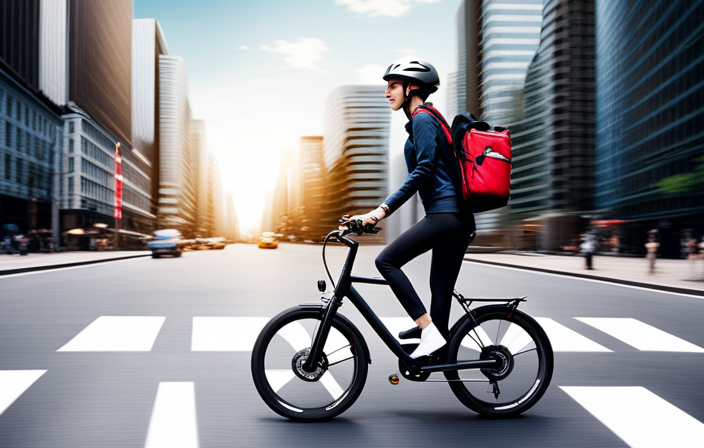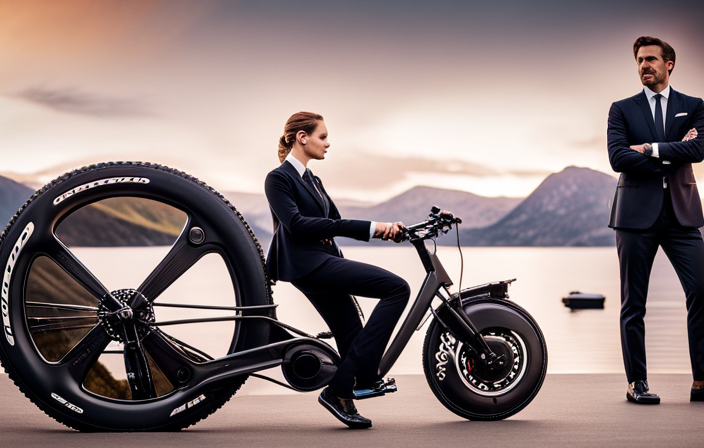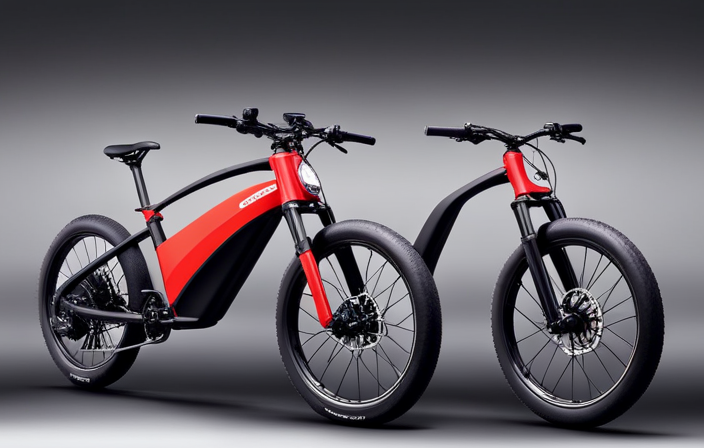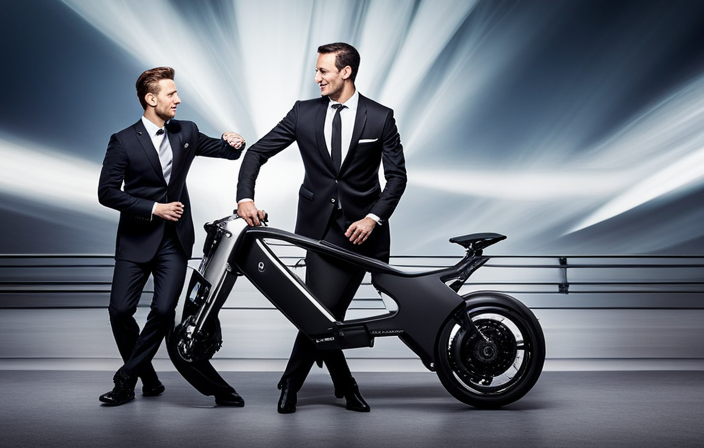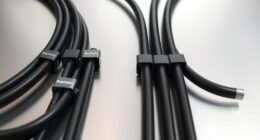As a devoted cyclist, I was astonished to learn that the worldwide electric bike market is expected to exceed $23 billion by 2025. Given this rapid expansion, it’s not surprising that selecting the optimal motor for an electric bike can be overwhelming.
In this article, I will delve into the technical nuances of hub motors, mid-drive motors, rear wheel motors, and front wheel motors. By understanding the pros and cons of each option, you’ll be equipped to make an informed decision on which motor suits your specific needs.
Key Takeaways
- Hub motors, mid-drive motors, rear wheel motors, and front wheel motors are different types of electric bike motors.
- Each type of motor has its own advantages and disadvantages.
- Factors to consider when choosing a motor include legal restrictions, power and torque requirements, off-road riding needs, and sensor types.
- Battery compatibility, including life, charging time, capacity, and power storage, is also an important factor to consider.
Understanding Electric Bike Motors
Understanding electric bike motors is crucial when determining the best motor for an electric bike. Motor efficiency is a key factor to consider. A more efficient motor will provide better performance and longer battery life. To ensure motor efficiency, regular motor maintenance is essential.
This includes keeping the motor clean and free from debris, as well as lubricating the moving parts as needed. Regular inspections should also be conducted to identify any potential issues before they become major problems. By properly maintaining the motor, its efficiency can be maximized, resulting in a smoother and more enjoyable riding experience.
Now, let’s delve into the different types of electric bike motors, starting with hub motors.
Hub Motors
Hub motors are commonly used in e-bikes because of their ease of installation and maintenance. These motors are integrated into the wheel hub, providing a compact and streamlined design. Let’s take a closer look at the advantages and disadvantages of hub motors:
| Advantages | Disadvantages |
|---|---|
| Easy installation | Increased weight |
| Low maintenance | Limited torque |
| Direct power transmission | Limited gear options |
| Silent operation | Reduced efficiency |
One of the key advantages of hub motors is their easy installation, as they simply replace the existing wheel hub. Additionally, they require minimal maintenance due to their sealed design. Hub motors offer direct power transmission, resulting in a smooth and efficient ride. However, they do have some drawbacks. Hub motors add weight to the bike, affecting its handling and maneuverability. They also have limited torque and gear options, which can impact performance on steep hills or off-road terrains. Despite these disadvantages, hub motors remain a popular choice for e-bike enthusiasts.
Moving on to the next section about mid-drive motors, these motors offer distinct advantages in terms of power and efficiency.
Mid-Drive Motors
Take a closer look at why mid-drive motors are a popular choice for e-bike enthusiasts like yourself.
These motors are known for their superior motor efficiency, durability, and low maintenance requirements.
The key advantage of a mid-drive motor is its ability to transfer power directly to the drivetrain, resulting in increased efficiency.
By driving the crankshaft, the motor utilizes the bike’s gears, allowing for better torque and hill-climbing capabilities.
Moreover, mid-drive motors are positioned at the bike’s center, providing a more balanced and stable ride.
Additionally, their compact design ensures better ground clearance and protection against impacts.
When it comes to maintenance, mid-drive motors are easier to service as they can be accessed without removing the rear wheel.
Now, let’s delve into the next section about rear wheel motors and their unique features.
Rear Wheel Motors
To fully experience the benefits of a rear wheel motor, you’ll notice an increase in power and traction while riding your e-bike. The rear wheel motor is located in the hub of the rear wheel, providing direct power to the wheel itself. This positioning offers several advantages.
First, it allows for better weight distribution, as the motor is located at the back of the bike. This results in improved balance and stability, especially when going uphill or navigating rough terrain. Additionally, the rear wheel motor offers enhanced traction, particularly in wet or slippery conditions.
However, there are also a few disadvantages to consider. The main drawback is that the rear wheel motor can add extra weight to the bike, which may affect maneuverability. Furthermore, if you encounter a flat tire, it can be more challenging to repair or replace the rear wheel motor.
Transitioning to the next section about front wheel motors, let’s explore their unique features.
Front Wheel Motors
When considering different options for your e-bike, you’ll find that front wheel motors offer their own set of advantages and considerations.
One advantage of front wheel conversion is that it is relatively easy to install, making it a popular choice for DIY enthusiasts. Additionally, having the motor in the front gives the bike better traction, especially when climbing hills or in wet conditions.
However, there are also some disadvantages to front wheel motors. One major drawback is that they can affect the bike’s handling and balance, as the weight distribution is shifted towards the front. This can make the steering feel heavier and less responsive. Another consideration is that front wheel motors may not be as efficient as rear wheel motors, resulting in reduced range.
Transitioning into the next section, let’s now explore the benefits of high-speed motors.
High-Speed Motors
When considering high-speed motors for various applications, it’s important to analyze their speed and performance capabilities.
These motors are designed to operate at higher speeds, allowing for faster acceleration and higher top speeds.
However, it’s crucial to understand the legal restrictions and regulations surrounding high-speed motors, as different regions may have specific speed limits and requirements.
Additionally, when choosing a high-speed motor, considerations such as power requirements, torque output, and efficiency should be taken into account. This ensures optimal performance and compatibility with the intended application.
Speed and Performance of High-Speed Motors
The high-speed motor’s performance is crucial for achieving maximum speed on an electric bike. As a rider, I have experienced the advantages and disadvantages of high-speed motors firsthand. Here are three key points to consider:
Advantages of high-speed motors:
- Increased top speed: High-speed motors allow for faster acceleration and higher top speeds, giving riders a thrilling experience.
- Improved hill climbing ability: These motors provide more torque, making it easier to climb steep inclines.
- Enhanced performance: High-speed motors offer smoother and more responsive power delivery, resulting in a more enjoyable riding experience.
Disadvantages of high-speed motors:
- Reduced range: The increased power demands of high-speed motors can lead to a shorter battery life, limiting the distance a rider can travel.
- Higher cost: High-speed motors are usually more expensive compared to lower speed options, potentially increasing the overall cost of the electric bike.
- Legal restrictions: Some regions have regulations limiting the maximum speed of electric bikes, making high-speed motors illegal or requiring additional licensing.
Considering the advantages and disadvantages, it is important to keep in mind the legal restrictions and regulations for high-speed motors. Transitioning into the subsequent section, it is crucial to understand the legal implications and compliance requirements when choosing a high-speed motor for an electric bike.
Legal Restrictions and Regulations for High-Speed Motors
After exploring the speed and performance capabilities of high-speed motors, it is important to understand the legal restrictions and regulations surrounding these powerful components.
Many countries and regions have specific guidelines in place to ensure the safe and responsible use of electric bike motors. One common regulation is the imposition of speed limits for electric bike motors. These limits vary depending on the jurisdiction, with some countries allowing motors to propel bikes up to 25 kilometers per hour, while others permit speeds up to 45 kilometers per hour. It is crucial for electric bike enthusiasts to familiarize themselves with the specific regulations in their area to avoid any legal complications.
Furthermore, manufacturers often design motors to comply with these regulations, ensuring that their products are within the legal speed limits. Considering these electric bike motor regulations, it is now essential to delve into the considerations for choosing a high-speed motor.
Considerations for Choosing a High-Speed Motor
One important factor to consider when choosing a high-speed motor is the desired speed range. High-speed motors are designed to operate at faster speeds, providing greater efficiency and performance.
Efficiency is crucial in high-speed motors as it directly impacts energy consumption and overall performance. A high-speed motor with high efficiency will convert a larger percentage of electrical energy into mechanical energy, resulting in less wasted energy and lower operating costs.
Motor reliability and longevity are also essential considerations. High-speed motors must be built to withstand the demands of high speeds and maintain optimal performance over time. Components such as bearings, cooling systems, and insulation materials must be carefully selected to ensure durability and minimize wear and tear.
Transitioning to the subsequent section on low-speed motors, it is important to understand the differences in requirements for these motors.
Low-Speed Motors
When it comes to low-speed motors, two important factors to consider are power and torque. Power refers to the rate at which work is done, while torque is the rotational force generated by the motor.
Low-speed motors typically have higher torque, which is beneficial for off-road riding as it provides better traction and control in challenging terrain.
However, when choosing a low-speed motor, other factors such as efficiency, weight, and battery life should also be taken into account to ensure the optimal performance for your specific needs.
Power and Torque of Low-Speed Motors
To determine the best motor for your electric bike, you should consider the power and torque of low-speed motors.
Low-speed motors are known for their excellent power and efficiency, making them ideal for electric bikes.
These motors are designed to provide high torque at low speeds, allowing you to tackle hilly terrains and start from a standstill easily. This is particularly beneficial for off-road riding, where you may encounter steep inclines and uneven surfaces.
Additionally, low-speed motors require less maintenance compared to high-speed motors, resulting in increased longevity and reduced costs in the long run.
With their impressive power and efficiency, low-speed motors offer the perfect balance between performance and reliability for your electric bike.
Benefits of Low-Speed Motors for Off-Road Riding
If you want to conquer steep inclines and navigate uneven surfaces with ease, low-speed motors are your go-to choice for off-road riding. These motors offer several benefits that make them ideal for tackling challenging terrains.
One of the key advantages is their ability to provide high torque at low speeds, which is crucial for powering through tough obstacles. Additionally, low-speed motors have lower power requirements compared to high-speed motors, making them more energy-efficient and allowing for longer rides.
Their terrain adaptability is also impressive, as they can handle various off-road conditions such as mud, rocks, and steep gradients. When choosing a low-speed motor, there are a few factors to consider, which we will delve into in the next section.
Factors to Consider When Choosing a Low-Speed Motor
Consider your specific needs and requirements when selecting a low-speed motor for off-road riding.
When it comes to power vs efficiency, low-speed motors excel in providing high torque and climbing ability. These motors are designed to deliver maximum power output at lower speeds, making them ideal for tackling steep inclines and rough terrains.
However, it’s important to weigh this power against the efficiency of the motor, as it can impact the overall range of your electric bike.
Additionally, cost is another factor to consider. Low-speed motors tend to be more affordable compared to higher speed counterparts, making them a budget-friendly choice for off-road enthusiasts.
With these considerations in mind, let’s now transition into the subsequent section about mid-speed motors, which offer a different set of advantages and features.
Mid-Speed Motors
You should definitely check out mid-speed motors for your electric bike. These motors offer a great balance between power and efficiency, making them a popular choice among electric bike enthusiasts. Here is a comparison table highlighting the advantages and disadvantages of mid-speed motors:
| Advantages | Disadvantages |
|---|---|
| Higher top speed | Limited torque |
| Improved efficiency | Reduced hill-climbing ability |
| Longer battery life | Limited off-road capability |
| Quieter operation | Limited acceleration |
| Smoother ride | Higher cost |
Mid-speed motors provide a higher top speed and improved efficiency compared to low-speed motors. They also offer a smoother ride and quieter operation. However, mid-speed motors have some disadvantages, such as limited torque and reduced hill-climbing ability. They may not perform as well in off-road conditions and have limited acceleration. Additionally, mid-speed motors tend to be more expensive. Transitioning to the next section about ‘brushed motors,’ these motors have their own unique characteristics.
Brushed Motors
Transitioning to the next section, brushed motors have their own unique characteristics.
One advantage of brushed motors is their simplicity. They have fewer components compared to brushless motors, which makes them easier to manufacture and repair.
Additionally, brushed motors have a higher starting torque, allowing for quick acceleration.
However, there are also some disadvantages to using brushed motors. They are less efficient compared to brushless motors, resulting in lower overall performance and shorter battery life. Brushed motors also require regular maintenance due to the wear and tear on the brushes.
As we move forward, it is important to consider these limitations and explore the alternatives offered by brushless motors, which we will discuss in the next section.
Brushless Motors
Brushless motors, on the other hand, offer improved efficiency and longer lifespan compared to brushed motors. These motors have several advantages over their brushed counterparts. One major advantage is their higher efficiency. Brushless motors are able to convert a higher percentage of electrical energy into mechanical power, resulting in less energy waste and a longer battery life. Additionally, brushless motors do not have brushes that can wear out over time, leading to a longer lifespan. They also produce less noise and require less maintenance. In terms of performance, brushless motors provide smoother and more precise control, making them ideal for applications that require high torque and speed. Overall, brushless motors are a superior choice for electric bikes due to their efficiency and durability.
| Advantages of Brushless Motors | Efficiency |
|---|---|
| Improved efficiency | High |
| Longer lifespan | High |
| Less maintenance | High |
| Smoother control | High |
Moving on to torque sensors, these devices play a crucial role in enhancing the performance of electric bikes.
Torque Sensors
When riding, it’s important to have a torque sensor that accurately measures your pedaling power to provide a smooth and responsive riding experience. Torque sensors are essential components in electric bikes as they offer several benefits.
Firstly, torque sensors provide a more natural and intuitive riding experience by delivering power in proportion to the rider’s effort. This means that as you pedal harder, the motor responds with more assistance, making it feel like an extension of your own strength.
Additionally, torque sensors allow for better control and efficiency. They adjust the motor’s output based on the force applied, ensuring power is delivered precisely when needed, resulting in improved energy efficiency and longer battery life.
In contrast, cadence sensors only measure the rotation speed of the pedals, providing a less accurate representation of the rider’s effort and resulting in less intuitive power delivery.
As we move on to discussing cadence sensors, it’s important to understand the limitations they have compared to torque sensors.
Cadence Sensors
Cadence sensors, on the other hand, measure the rotation speed of the pedals, providing a different approach to measuring the rider’s effort. Unlike torque sensors, which focus on the force applied to the pedals, cadence sensors focus on the speed at which the pedals are rotating. By measuring the number of rotations per minute (RPM), cadence sensors can provide valuable information about the rider’s pedaling technique and efficiency.
One of the main benefits of cadence sensors is that they can help cyclists maintain an optimal pedaling cadence. Studies have shown that a cadence of around 80-100 RPM is generally considered efficient for most riders. By monitoring cadence, cyclists can adjust their pedaling speed to stay within this range, which can enhance their overall performance and reduce the risk of fatigue or injury.
Another advantage of cadence sensors is that they can provide real-time feedback to cyclists. By displaying the current cadence on a connected device or bike computer, riders can make immediate adjustments to their pedaling technique and maintain a consistent pace. This can be particularly useful during training sessions or races, where maintaining a specific cadence can be crucial for achieving optimal performance.
Transitioning to the next section about power sensors, it is important to note that cadence sensors alone do not provide a complete picture of a rider’s effort. While they can give insight into pedaling technique and efficiency, power sensors offer a more comprehensive measurement of the rider’s overall output.
Power Sensors
Power sensors, also known as wattmeters, measure the amount of power generated by the cyclist’s legs, providing a direct measurement of their effort. These sensors play a crucial role in enhancing power efficiency, as they allow cyclists to monitor and optimize their power output. When it comes to durability and maintenance, power sensors are designed to withstand the rigorous demands of cycling, ensuring long-lasting performance. They are typically constructed with high-quality materials and are resistant to water and shock. Additionally, power sensors require minimal maintenance, with periodic battery replacements being the only necessary upkeep. Here is a table summarizing the key features of power sensors:
| Feature | Description |
|---|---|
| Power Measurement | Direct measurement of power generated by the cyclist’s legs |
| Durability | Built to withstand water and shock, ensuring long-lasting performance |
| Maintenance | Minimal maintenance required, occasional battery replacements |
Considering the importance of power sensors in optimizing performance, the next section will delve into battery compatibility, a crucial aspect of electric bike systems.
Battery Compatibility
Battery compatibility can greatly impact the overall performance of a cyclist’s electric bike system. When choosing a battery for your electric bike, it is essential to consider factors such as battery life, charging time, compatibility with the motor, and capacity.
Battery life: The lifespan of a battery determines how long it will last before needing to be replaced. Opting for a high-quality battery with a longer lifespan ensures that you can enjoy your electric bike for an extended period without worrying about frequent replacements.
Charging time: The charging time of a battery dictates how quickly you can get back on the road. Look for batteries that have fast charging capabilities, allowing you to recharge your bike quickly and conveniently.
Compatibility with the motor: Ensuring that the battery is compatible with your electric bike motor is crucial for optimal performance. Check the specifications of your bike and choose a battery that is specifically designed to work with your motor.
Capacity: The capacity of the battery determines how much power it can store. Higher capacity batteries allow for longer rides without needing to recharge.
Considering these factors will help you make an informed decision when selecting a battery for your electric bike. Transitioning to the next section, let’s explore the various factors to consider when making your decision.
Making Your Decision
When it comes to making a decision about which motor is best for your electric bike, there are several key points to consider.
First, assessing your riding needs and preferences is crucial in determining the type of motor that will suit you best.
Consulting experts and reading reviews can provide valuable insights and recommendations based on their expertise and experiences.
Assessing Your Riding Needs and Preferences
Before deciding on the best motor for an electric bike, it’s important to assess your riding needs and preferences.
Evaluating motor efficiency and comparing motor power are two key factors to consider.
When it comes to efficiency, you’ll want to look at how the motor converts electrical energy into mechanical motion. A more efficient motor will provide longer battery life and greater overall range.
Comparing motor power involves looking at the maximum output of the motor in terms of watts or horsepower. This will determine the bike’s acceleration and top speed capabilities.
By evaluating these aspects, you can determine the motor that best suits your riding style and terrain.
Consulting experts and reviews can provide valuable insights into the performance and reliability of different motors, helping you make an informed decision.
Consulting Experts and Reviews
By consulting experts and reading reviews, you can gain valuable insights into which motor suits your riding style and terrain. When evaluating motor efficiency, it is important to consider factors such as power output, torque, and battery consumption. Experts can provide detailed information on these specifications and how they affect the overall performance of the motor.
Additionally, comparing motor prices is crucial in order to find a balance between affordability and quality. Reviews from other riders can offer real-world experiences and opinions on the durability and reliability of different motors. This information can help you make an informed decision when choosing the best motor for your electric bike.
Now, let’s move on to the next section where we will discuss the importance of test riding and evaluating different motors.
Test Riding and Evaluating Different Motors
To truly understand how different motors perform, you should take the time to test ride and evaluate them. Evaluating performance and comparing efficiency are essential steps in determining the best motor for an electric bike.
Here are four key factors to consider during the evaluation process:
-
Power Output: Test the motor’s power output by riding the bike on various terrains and inclines. This will help you gauge its performance in different conditions.
-
Torque: Pay attention to the motor’s torque, as it determines how quickly the bike accelerates and its ability to climb hills. A motor with higher torque will provide better performance in challenging situations.
-
Battery Life: Evaluate how the motor’s efficiency affects the bike’s battery life. Compare different motors to see which one can provide a longer ride time without needing frequent recharging.
-
Noise Level: Take note of the motor’s noise level during the test ride. A quieter motor can enhance the overall riding experience and reduce noise pollution.
Frequently Asked Questions
How do I determine the compatibility of a battery with a specific electric bike motor?
To determine battery compatibility with a specific electric bike motor, you need to consider factors such as voltage, capacity, and connector type. It’s crucial to consult the motor and battery specifications to ensure a proper match for optimal performance and safety.
Are torque sensors more accurate than cadence sensors in measuring the rider’s effort?
While torque sensors are generally considered more accurate than cadence sensors in measuring a rider’s effort, it’s important to note that accuracy can vary depending on the specific sensor technology used. Both sensors have their strengths and limitations in accurately measuring rider input.
Can I install a rear wheel motor on a bike that originally had a front wheel motor?
Yes, it is possible to convert a front wheel motor to a rear wheel motor. However, it is crucial to consider the motor power comparison and ensure compatibility with the bike frame and components.
What are the advantages of using a mid-drive motor over a hub motor?
The advantages of mid-drive motors include better weight distribution, improved handling, and increased hill-climbing ability. Conversely, hub motors have drawbacks such as increased unsprung weight, limited gear options, and reduced efficiency.
Are brushed motors still commonly used in electric bikes, or are brushless motors more popular now?
Brushed motors have several disadvantages, including lower efficiency, limited lifespan, and higher maintenance requirements. In contrast, brushless motors offer benefits such as higher efficiency, longer lifespan, and lower maintenance needs, making them more popular in electric bikes nowadays.
Conclusion
After thoroughly researching and analyzing the different types of electric bike motors, it is evident that choosing the best motor for your electric bike is a crucial decision.
With options like hub motors, mid-drive motors, rear wheel motors, and front wheel motors, each offering unique advantages, it can be overwhelming.
Additionally, the choice between cadence sensors and power sensors further adds to the complexity.
Furthermore, battery compatibility plays a significant role in determining motor performance.
So, which motor is the best? The answer lies in carefully considering your specific needs, preferences, and budget, in order to make an informed decision.

